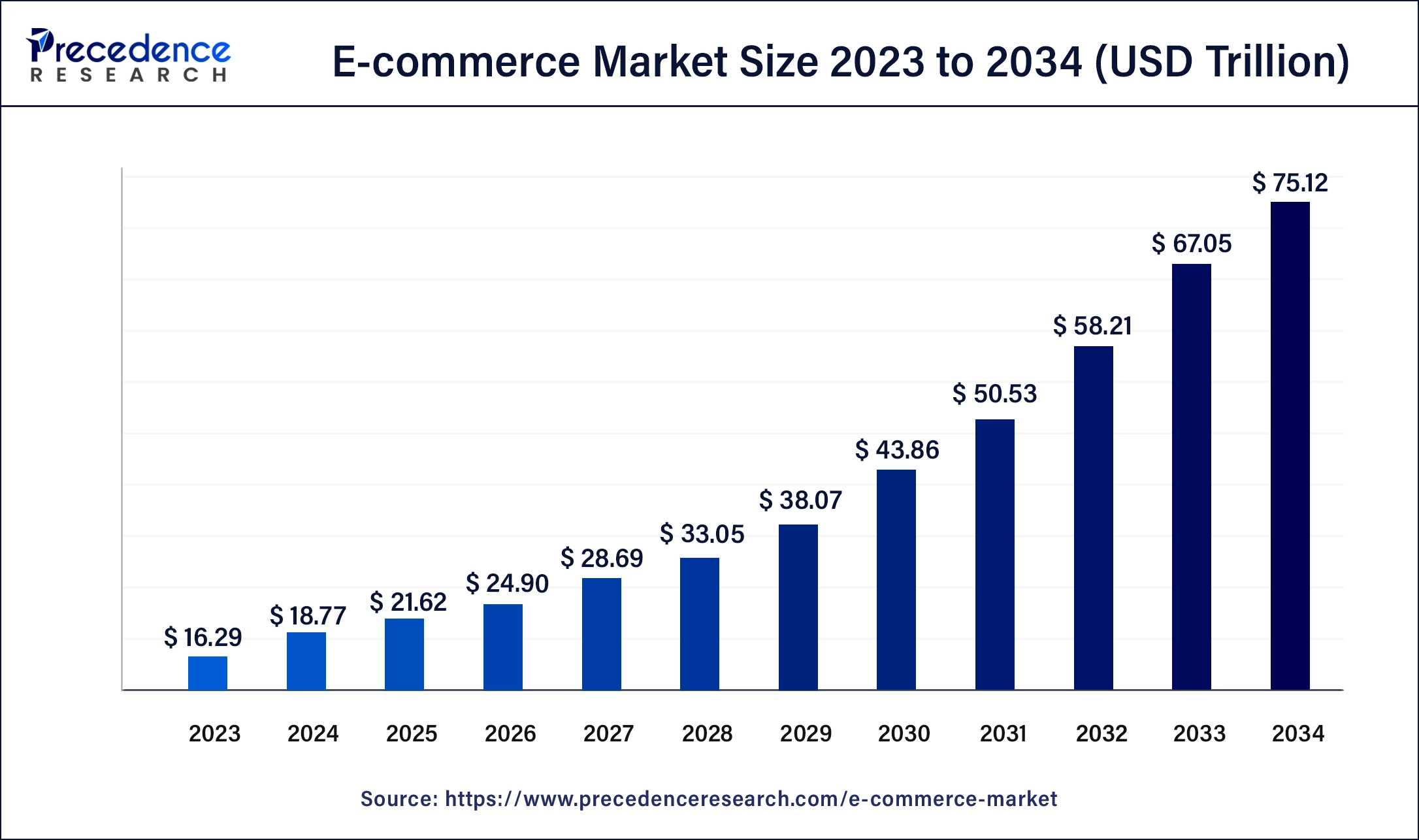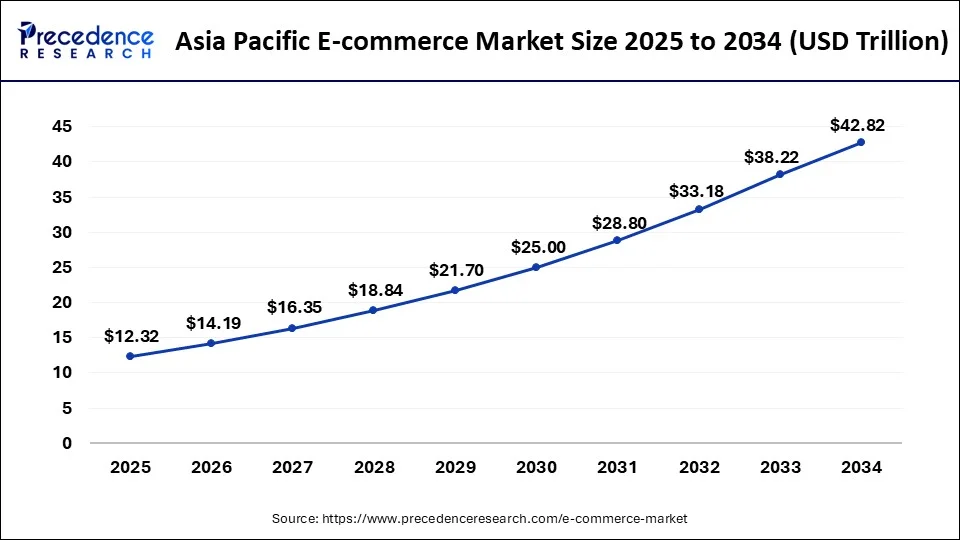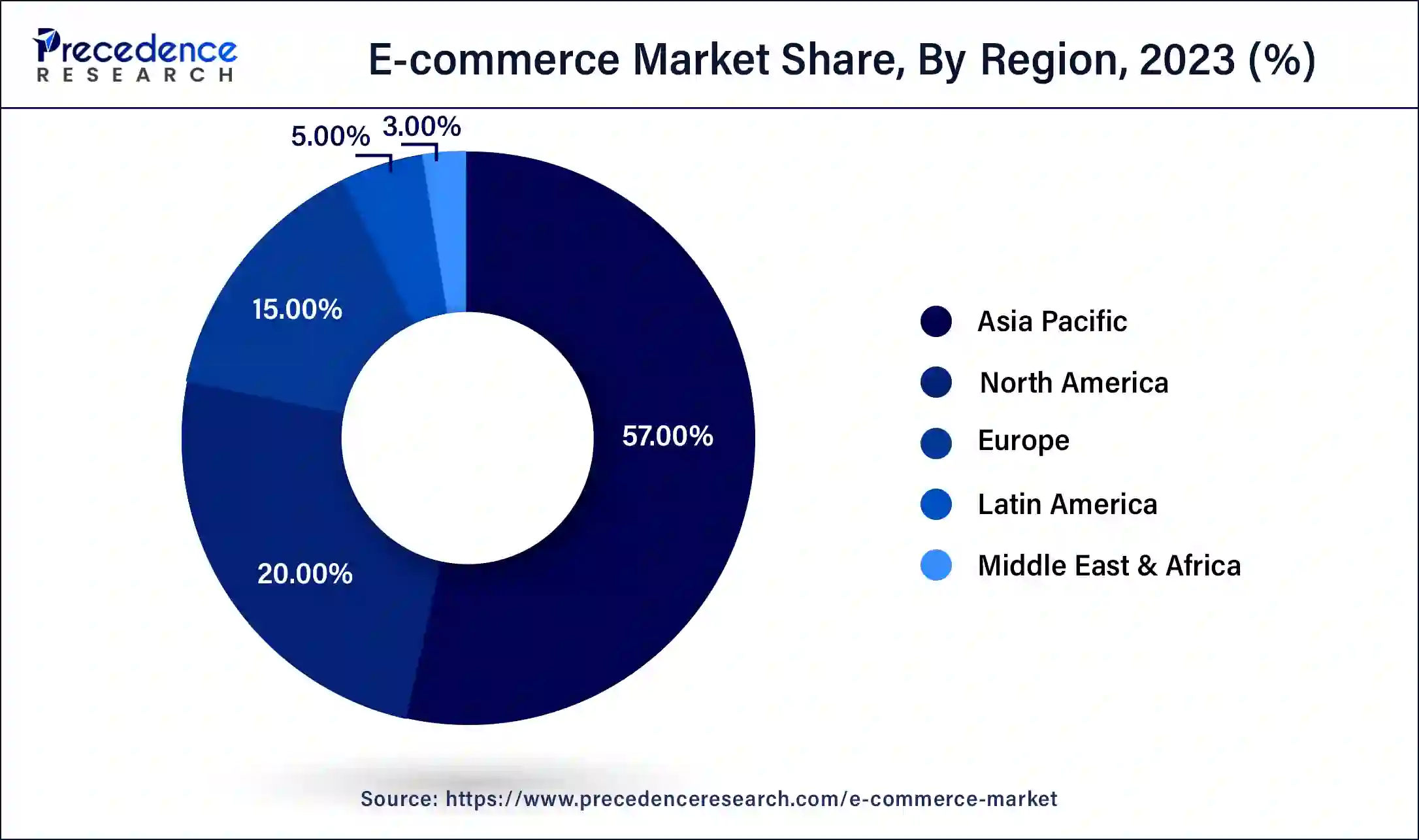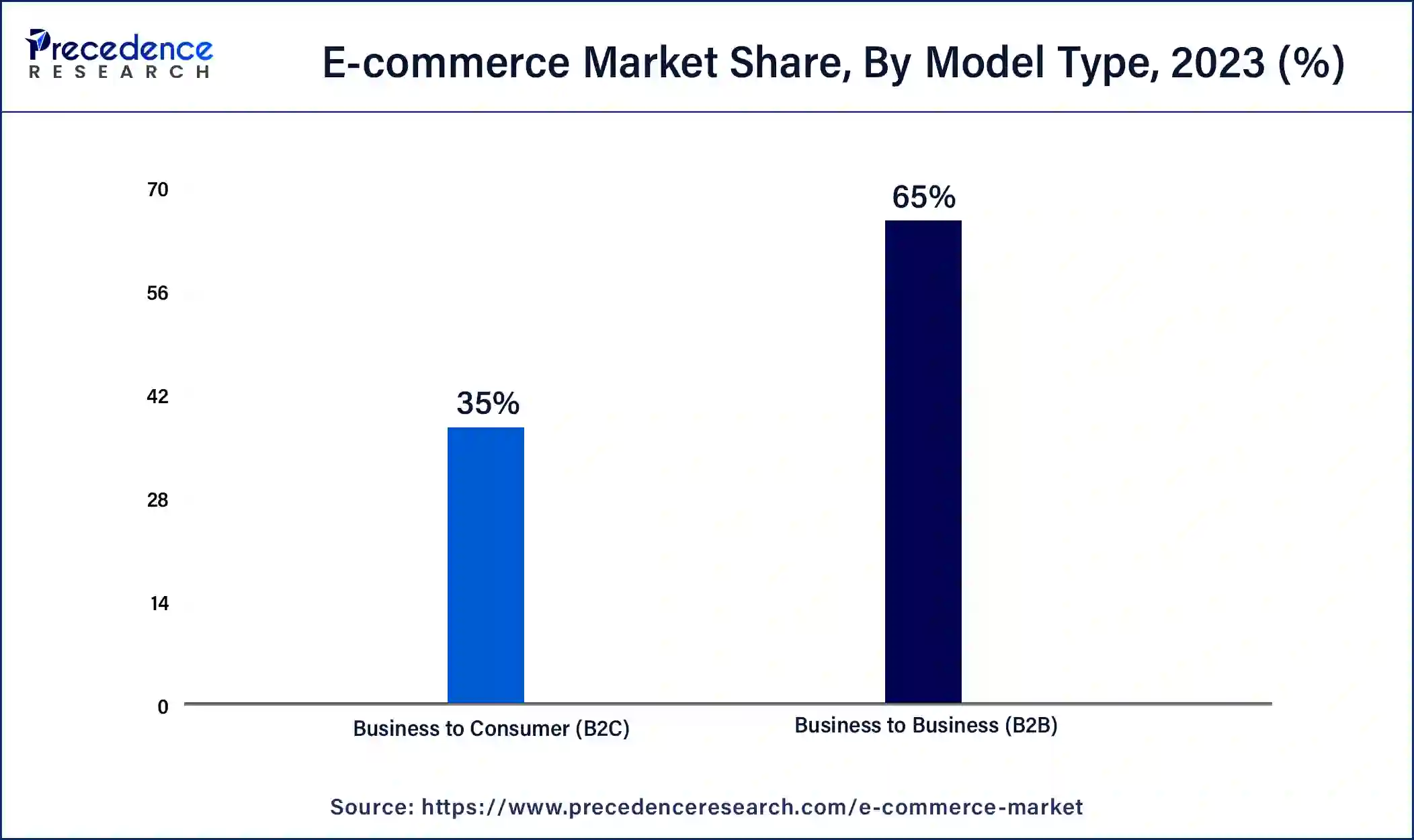List of Contents
E-commerce Market Size and Forecast 2025 to 2034
The global E-commerce market size accounted at USD 18.77 trillion in 2024 and is expected to be worth around USD 75.12 trillion by 2034, at a CAGR of 14.88% from 2025 to 2034.

E-commerce Market Key Takeaways
- In terms of revenue, the E-commerce market is valued at $21.62 trillion in 2025.
- It is projected to reach $75.12 trillion by 2034.
- The E-commerce market is expected to grow at a CAGR of 14.88% from 2025 to 2034.
- Asia Pacific contributed more than 57% of revenue share in 2024.
- By Model Type, the Business to Business (B2B) segment captured more than 65% of revenue share in 2024.
- By application, the home appliances segment is expected to garner a significant market share over the forecast period.
Asia Pacific E-commerce Market Size and Growth 2024 to 2034
The Asia Pacific E-commerce market size was estimated at USD 10.70 trillion in 2024 and is predicted to be worth around USD 42.82 trillion by 2034, at a CAGR of 14.95% from 2025 to 2034.

Asia Pacific is expected to dominate the market over the forecast period.The market growth in the region is attributed to the growing urbanization and increasing investment in network infrastructure especially in the countries like India, China and Japan. For instance, as per United Nations Human Settlements Program, in Asia-Pacific area, urbanization is still a defining megatrend. Asia is home to more than 2.2 billion people or 54% of the world's metropolitan population.
Currently, Asia Pacific is dominating the e-commerce market. Within the region, China contributes the most with its largest market share in the market. China is the sole competitor with the highest e-commerce sales globally. The rising demand for e-commerce in industries leads to the expansion of several businesses across regions.
Additionally, according to the latest report published by GSMA “Mobile Economy Asia Pacific” in 2022, more than 400 million 5G connections, or slightly over 14% of all mobile connections, will exist by 2025. In addition, according to IBEF, the majority of the industry's growth has been driven by internet and smartphone use. The 'Digital India' program caused a dramatic increase in internet connections, reaching 850 million in 2022 in India. Furthermore, the rising government initiative is also one of the important factors that propel the market expansion in the region during the forecast period.
North America is expected to hold a prominent market share over the forecast period. The market growth in the region is driven by the well-established digital infrastructures and the presence of major e-commerce companies including Amazon, Walmart, eBay and others. Amazon, in particular, has a substantial share of the market and offers a wide range of products, including its Amazon Prime subscription service. Amazon continues to be the industry leader in retail e-commerce with a market share of 37.8%.
Moreover, the COVID-19 pandemic is one of the major reciprocating factors that has influenced the market growth in the region. For instance, E-commerce sales rose from $571.2 billion in 2019 to $815.4 billion in 2020, the first year of the pandemic, according to the most recent 2020 ARTS release, a surge of $244.2 billion or 43%. Therefore, the aforementioned facts drive the market growth in the region over the forecast period.

Market Overview
The advent of the internet and digital technologies has revolutionized the way business is conducted, giving rise to the booming phenomenon known as e-commerce. E-commerce, or electronic commerce, includes the online buying or selling of goods. The e-commerce services hold the capacity to transform the global marketplace in profound ways. This virtual marketplace eliminates the constraints of physical distance and opens up new avenues for businesses to connect with consumers, making it an essential aspect of modern commerce.
E-commerce has evolved from a novel concept into a multi-trillion-dollar industry, reshaping the traditional retail landscape and redefining consumer behavior. The ease of access, convenience, and a limitless variety of products and services available on e-commerce platforms have attracted a massive number of customers, fundamentally altering the way people shop and interact with businesses. The e-commerce landscape is characterized by its constant evolution, driven by innovations in payment systems, logistics, user experience, and data analytics.
- According to the GSMA, a third of the world's population, or around 1.2 billion connections, will be covered by 5G networks by 2025.
E-commerce Market Growth Factors
The rise of mobile devices and apps has extended the reach of e-commerce, enabling customers to shop on the go. Moreover, emerging technologies like artificial intelligence (AI), virtual reality (VR), and augmented reality (AR) are transforming how products are showcased and experienced online. The global e-commerce market is driven by the increasing integration of advanced technologies such as AI, VR and AR, the growing inclination of consumers towards online shopping, rising investment, growing collaboration and increasing government initiatives.
Market Scope
| Report Coverage | Details |
| Market Size in 2024 | USD 18.77 Trillion |
| Market Size in 2025 | USD 21.62 Trillion |
| Market Size by 2034 | USD 75.12 Trillion |
| Growth Rate from 2025 to 2034 | CAGR of 14.88% |
| Largest Market | Asia Pacific |
| Base Year | 2024 |
| Forecast Period | 2025 to 2034 |
| Segments Covered | By Model Type and By Application |
| Regions Covered | North America, Europe, Asia-Pacific, Latin America, and Middle East & Africa |
Market Dynamics
Driver
Rising penetration of the internet
The widespread availability of the internet, along with increased access through smartphones and other devices, has enabled a larger portion of the global population to connect and shop online. As more people gain internet access, the potential customer base for e-commerce continues to expand. For instance, according to the Internet in India Report 2022, in India, the number of internet active users is around 759 million and is expected to reach around 900 million by 2025. Out of 759 million, about 399 million are from rural areas and 360 million from urban areas. Therefore, the growing number of internet users across the globe is expected to flourish the e-commerce industry over the projected year.
Restraint
Cybersecurity concerns
As e-commerce transactions involve the exchange of sensitive personal and financial information, the risk of cyberattacks, data breaches, and identity theft is a major concern. Businesses must invest in robust cybersecurity measures to protect customer data and maintain trust. For instance, according to secondary analysis, Account Take Over (ATO), which increased by 131% in the second half of 2022 compared to H1 in 2021, continues to be an e-commerce fraud issue in 2023. Thus, the growing cybersecurity concern is expected to hamper the market growth over the forecast period.
Opportunity
Increasing government initiatives
The increasing government initiatives are expected to provide a lucrative opportunity for market growth over the forecast period. For instance, the Union Ministry of India launched Bharat Craft, an Indian e-commerce website patterned after Alibaba. Multiple governments across the globe are penetrating online services to boost the sales of locally-produced goods to improve businesses. All these elements along with a substantial focus on cyber regulations by government authorities will present opportunities for the market to grow.
Technological Advancement
Technological advancements in the e-commerce market feature mobile commerce, voice commerce, blockchain, and AI. Voice commerce is a fascinating technology, popularly approached by half of the population, introducing a smart assistant to individuals. It includes Google Assistant and Alexa, supporting customers in browsing and purchasing products with the help of voice commands. Mobile commerce, smartphones are mainly preferred by users for easy payment options and access to other applications. Blockchain technology strengthens the supply chain process by tracking, reporting details, also ensures safety in online payments.
Artificial intelligence (AI), a popular technology, offers personalized features for a better shopping experience. AI assists and guides users through virtual assistance and chatbots. The advancement is contributing to financial safety with contactless payment options such as QR codes, NFC, and mobile wallets. The innovation in the e-commerce market is uplifting development in existing businesses and paving the way for new businesses.
Model Type Insights
Based on the model type, the global E-commerce market is segmented into Business to Business (B2B) and Business to Consumer (B2C). The Business to Business (B2B) segment is expected to hold the largest market share over the forecast period. B2B e-commerce encompasses a wide range of industries, products, and services, from industrial machinery and raw materials to software solutions and professional services. It involves various online platforms, websites, and marketplaces that facilitate these transactions. B2B e-commerce transactions can include bulk orders, ongoing supply agreements, subscription-based services, and more. The increasing propensity of businesses to sell and purchase products and services online is credited with the segment's rise.

Furthermore, it is predicted that during the period of the projection year, the business-to-business e-commerce market would be driven by rising smartphone adoption and internet usage. For instance, according to secondary analysis, In 2022, 84 percent of all mobile connections will be in North America, which will have the greatest adoption rate of smartphones. By 2030, 90 percent of smartphones will be in use in North America, with the CIS and Asia Pacific predicted to have the fastest growth. Therefore, the aforementioned fact drives the segment growth during the forecast period.
Application Insights
Based on the application, the global e-commerce market is segmented into home appliances, fashion products, groceries, books, and others. The home appliances segment is expected to garner a significant market share over the forecast period. Home appliances available in the e-commerce websites encompass a wide range of products that are essential for daily living, such as kitchen appliances, laundry machines, air conditioning units, and more. The convenience, variety, and competitive pricing offered by e-commerce platforms have contributed to the expansion of online sales in the home appliances sector.
On the other hand, the fashion products segment is expected to grow at the highest CAGR over the forecast period. Fashion e-commerce encompasses a wide range of products, including clothing, footwear, accessories, and beauty products. The convenience, extensive product range, and trends-driven nature of fashion have contributed to the rapid growth of online fashion retail. For instance, Myntra predicts that in the following five years, the Indian fashion eCommerce market would reach $30 billion. This indicates that during the next five years, about one-third of India's fashion will be marketed online or via digital channels.
E-commerce Market Companies
- Apple Inc.
- Amazon.com Inc.
- Flipkart Internet Pvt. Ltd.
- Costco Wholesale Corp.
- Ebates Performance Marketing Inc.
- eBay Inc.
- Best Buy Co. Inc.
- Groupon Inc.
- Inter IKEA Systems B.V.
- JD.com Inc.
- Otto GmbH & Co. KG
- Lojas Americanas S.A.
- priceline.com LLC
- Shopify Inc.
- The Home Depot Inc.
Recent Development
- In May 2025, Davalindia, India's largest private retail chain specializing in generic medicines, launched its e-commerce platform in Varanasi, providing accessibility and affordable healthcare through digital channels. Source: indianretailer.com
- In May 2025, Unicommerce, an e-commerce enablement software-as-a-service (SaaS) firm, processed more than 20 million quick commerce (Q-commerce) order items via its flagship platform, Uniware, in the last financial year. Source: business-standard.com
- In April 2022, ANS Commerce was purchased by Bengaluru-based Flipkart. The acquisition will improve Flipkart's marketplace for online shopping. An Indian company called ANS Commerce offers e-commerce services.
- In February 2023,Swaven, a prominent provider of eCommerce enablement and analytics software throughout EMEA, APAC, and LATAM, will be acquired by MikMak, the premier eCommerce acceleration platform for multichannel companies. The two businesses' merger opens the way for MikMak 3.0, the most cutting-edge eCommerce analytics platform in the world.
Segments Covered in the Report
By Model Type
- Business to Business (B2B)
- Business to Consumer (B2C)
By Application
- Home Appliances
- Fashion Products
- Groceries
- Books
- Others
By Geography
- North America
- Europe
- Asia-Pacific
- Latin America
- Middle East and Africa
For inquiries regarding discounts, bulk purchases, or customization requests, please contact us at sales@precedenceresearch.com
Frequently Asked Questions
Ask For Sample
No cookie-cutter, only authentic analysis – take the 1st step to become a Precedence Research client